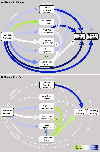Social and early life determinants of survival from cradle to grave: A case study in wild baboons
- PMID: 37321362
- PMCID: PMC10529797
- DOI: 10.1016/j.neubiorev.2023.105282
Social and early life determinants of survival from cradle to grave: A case study in wild baboons
Abstract
Field studies of natural mammal populations present powerful opportunities to investigate the determinants of health and aging using fine-grained observations of known individuals across the life course. Here, we synthesize five decades of findings from one such study: the wild baboons of the Amboseli ecosystem in Kenya. First, we discuss the profound associations between early life adversity, adult social conditions, and key aging outcomes in this population, especially survival. Second, we review potential mediators of the relationship between early life adversity and survival in our population. Notably, our tests of two leading candidate mediators-social isolation and glucocorticoid levels-fail to identify a single, strong mediator of early life effects on adult survival. Instead, early adversity, social isolation, and glucocorticoids are independently linked to adult lifespans, suggesting considerable scope for mitigating the negative consequences of early life adversity. Third, we review our work on the evolutionary rationale for early life effects on mortality, which currently argues against clear predictive adaptive responses. Finally, we end by highlighting major themes emerging from the study of sociality, development, and aging in the Amboseli baboons, as well as important open questions for future work.
Keywords: Baboon; Early life adversity; Life course studies; Social determinants of health; Social relationships.
Copyright © 2023 Elsevier Ltd. All rights reserved.
Figures




Similar articles
-
Accelerated reproduction is not an adaptive response to early-life adversity in wild baboons.Proc Natl Acad Sci U S A. 2020 Oct 6;117(40):24909-24919. doi: 10.1073/pnas.2004018117. Epub 2020 Sep 21. Proc Natl Acad Sci U S A. 2020. PMID: 32958642 Free PMC article.
-
Early life adversity and adult social relationships have independent effects on survival in a wild primate.Sci Adv. 2023 May 19;9(20):eade7172. doi: 10.1126/sciadv.ade7172. Epub 2023 May 17. Sci Adv. 2023. PMID: 37196090 Free PMC article.
-
Social bonds do not mediate the relationship between early adversity and adult glucocorticoids in wild baboons.Proc Natl Acad Sci U S A. 2020 Aug 18;117(33):20052-20062. doi: 10.1073/pnas.2004524117. Epub 2020 Aug 3. Proc Natl Acad Sci U S A. 2020. PMID: 32747546 Free PMC article.
-
Darwin's monkey: why baboons can't become human.Am J Phys Anthropol. 2012;149 Suppl 55:3-23. doi: 10.1002/ajpa.22158. Epub 2012 Oct 17. Am J Phys Anthropol. 2012. PMID: 23077093 Review.
-
Developmental responses to early-life adversity: Evolutionary and mechanistic perspectives.Evol Anthropol. 2019 Sep;28(5):249-266. doi: 10.1002/evan.21791. Epub 2019 Sep 9. Evol Anthropol. 2019. PMID: 31498945 Review.
Cited by
-
Re-wilding model organisms: Opportunities to test causal mechanisms in social determinants of health and aging.Neurosci Biobehav Rev. 2023 Sep;152:105238. doi: 10.1016/j.neubiorev.2023.105238. Epub 2023 May 22. Neurosci Biobehav Rev. 2023. PMID: 37225063 Free PMC article. Review.
-
Scars and PARs in a close relative.Proc Natl Acad Sci U S A. 2024 Mar 19;121(12):e2401971121. doi: 10.1073/pnas.2401971121. Epub 2024 Mar 11. Proc Natl Acad Sci U S A. 2024. PMID: 38466859 Free PMC article. No abstract available.
-
Wild capuchin monkeys as a model system for investigating the social and ecological determinants of ageing.Philos Trans R Soc Lond B Biol Sci. 2024 Dec 16;379(1916):20230482. doi: 10.1098/rstb.2023.0482. Epub 2024 Oct 28. Philos Trans R Soc Lond B Biol Sci. 2024. PMID: 39463253 Review.
-
Energetic Priorities Across the Stages of Development: Effects of Age, Sex, and Seasonal Reproduction on Activity Budgets in Verreaux's sifaka (Propithecus verreauxi).Am J Primatol. 2025 Jun;87(6):e70057. doi: 10.1002/ajp.70057. Am J Primatol. 2025. PMID: 40544369 Free PMC article.
-
Early-life paternal relationships predict adult female survival in wild baboons.Proc Biol Sci. 2025 Jun;292(2049):20250194. doi: 10.1098/rspb.2025.0194. Epub 2025 Jun 18. Proc Biol Sci. 2025. PMID: 40527463 Free PMC article.
References
-
- Abbott DH, Keverne EB, Bercovitch FB, Shively CA, Mendoza SP, Saltzman W, Snowdon CT, Ziegler TE, Banjevic M, Garland T Jr, 2003. Are subordinates always stressed? A comparative analysis of rank differences in cortisol levels among primates. Hormones and behavior 43, 67–82. - PubMed
-
- Alberts SC, Altmann J, 1995a. Balancing costs and opportunities: dispersal in male baboons. The American Naturalist 145, 279–306.
-
- Alberts SC, Altmann J, 1995b. Preparation and activation: determinants of age at reproductive maturity in male baboons. Behavioral Ecology and Sociobiology 36, 397–406.
-
- Alberts SC, Altmann J, 2012. The Amboseli Baboon Research Project: 40 years of continuity and change, in: Kappeler PM, Watts D (Eds.), Long-term field studies of primates, Springer Verlag, Berlin, pp. 261–287.
Publication types
MeSH terms
Grants and funding
LinkOut - more resources
Full Text Sources

